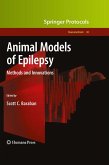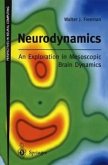Correlation is a vital element in epilepsy research, especially given the condition's notorious resistance to treatment. With a current 'rate of translation' estimated at between seven and nine years, and a translation 'success rate' of below 50 per cent, there is room for improvement in the correlative research exploring this intractable condition.
Epilepsy: Animal and Human Correlations offers judiciously selected material with clear correlative relevance. Arranged according to animal studies and related studies in the human population, each chapter covers clinical description, neurophysiology, neurochemistry, neuropathology, and treatment attempts. The human chapters have an additional section detailing studies based on counterpart animal studies, as well as covering promising further research suggested by animal results. The book includes a clear statement of the rationale for future human clinical investigations based on animal results.
The chapters cover animal and human studies related to both simple and complex partial seizures. It covers typical as well as atypical seizures, and includes material on some seizure disorders which resist neat classification. Studies conducted in the primate population receive careful attention
About the Author: The work of Dr. David W. McCandless spanned over 35 years of laboratory research into basic mechanisms of various metabolic encepha
lopathies. He was the Fo
unding Editor of the journal Metabolic Brain Disease (Springer), now in its 27th year. Dr. McCandless served on the faculty or research staff at The University of Vermont College of Medicine, NIH-NINCDS, University of Texas Medical School at Houston, and The Chicago Medical School, and was a visiting professor at Washington University School of Medicine. Most recently, he served as the John J. Sheinin Professor of Anatomy in the Department of Cell Biology and Anatomy at The Chicago Medical School, Rosalind Franklin University, North Chicago, IL, USA.
About the Author: The work of Dr. David W. McCandless spanned over 35 years of laboratory research into basic mechanisms of various metabolic encephalopathies. He was the Founding Editor of the journal Metabolic Brain Disease (Springer), now in its 27th year. Dr. McCandless served on the faculty or research staff at The University of Vermont College of Medicine, NIH-NINCDS, University of Texas Medical School at Houston, and The Chicago Medical School, and was a visiting professor at Washington University School of Medicine. Most recently, he served as the John J. Sheinin Professor of Anatomy in the Department of Cell Biology and Anatomy at The Chicago Medical School, Rosalind Franklin University, North Chicago, IL, USA.
About the Author: The work of Dr. David W. McCandless spanne
d over 35 years of laboratory research into basic mechan
isms of various metabolic encephalopathies. He was the Founding Editor of the journal Metabolic Brain Disease (Springer), now in its 27th year. Dr. McCandless served on the faculty or research staff at The University of Vermont College of Medicine, NIH-NINCDS, University of Texas Medical School at Houston, and The Chicago Medical School, and was a visiting professor at Washington University School of Medicine. Most recently, he served as the John J. Sheinin Professor of Anatomy in the Department of Cell Biology and Anatomy at The Chicago Medical School, Rosalind Franklin University, North Chicago, IL, USA.
About the Author: The work of Dr. David W. McCandless spanned over 35 years of laboratory research into basic mechanisms of various metabolic encephalopathies. He was the Founding Editor of the journal Metabolic Brain Disease (Springer), now in its 27th year. Dr. McCandless served on the faculty or research staff at The University of Vermont College of Medicine, NIH-NINCDS, University of Texas Medical School at Houston, and The Chicago Medical School, and was a visiting professor at Washington University School of Medicine. Most recently, he served as the John J. Sheinin Professor of Anatomy in the Department of Cell Biology and Anatomy at The Chicago Medical School, Rosalind Franklin University, North Chicago, IL, USA.
About the Author: The work of Dr. David W. McCandless spanned o
ver 35 years of laboratory research into basic mechanisms of various metabolic encephalopathies. He was the Founding Editor of the journal Metabolic Brain Disease (Springer), now in its 27th year. Dr. McCandless served on the faculty or research staff at The University of Vermont College of Medicine, NIH-NINCDS, University of Texas Medical School at Houston, and The Chicago Medical School, and was a visiting professor at Washington University School of Medicine. Most recently, he served as the John J. Sheinin Professor of Anatomy in the Department of Cell Biology and Anatomy at The Chicago Medical School, Rosalind Franklin University, North Chicago, IL, USA.
Epilepsy: Animal and Human Correlations offers judiciously selected material with clear correlative relevance. Arranged according to animal studies and related studies in the human population, each chapter covers clinical description, neurophysiology, neurochemistry, neuropathology, and treatment attempts. The human chapters have an additional section detailing studies based on counterpart animal studies, as well as covering promising further research suggested by animal results. The book includes a clear statement of the rationale for future human clinical investigations based on animal results.
The chapters cover animal and human studies related to both simple and complex partial s
eizures. It covers typical as well as atypical seizures, and includes material on some seizure diso
rders which resist neat classification. Studies conducted in the primate population receive careful attention
About the Author: The work of Dr. David W. McCandless spanned over 35 years of laboratory research into basic mechanisms of various metabolic encephalopathies. He was the Founding Editor of the journal Metabolic Brain Disease (Springer), now in its 27th year. Dr. McCandless served on the faculty or research staff at The University of Vermont College of Medicine, NIH-NINCDS, University of Texas Medical School at Houston, and The Chicago Medical School, and was a visiting professor at Washington University School of Medicine. Most recently, he served as the John J. Sheinin Professor of Anatomy in the Department of Cell Biology and Anatomy at The Chicago Medical School, Rosalind Franklin University, North Chicago, IL, USA.
About the Author: The work of Dr. David W. McCandless spanned over 35 years of laboratory research into basic mechanisms of various metabolic encephalopathies. He was the Founding Editor of the journal Metabolic Brain Disease (Springer), now in its 27th year. Dr. McCandless served on the faculty or research staff at The University of Vermont College of Medicine, NIH-NINCDS, University of Texas Medica
l School at Houston, and The Chicago Medical School, and was a visiting professor at Washington University School of Medicine. Most recently
, he served as the John J. Sheinin Professor of Anatomy in the Department of Cell Biology and Anatomy at The Chicago Medical School, Rosalind Franklin University, North Chicago, IL, USA.
About the Author: The work of Dr. David W. McCandless spanned over 35 years of laboratory research into basic mechanisms of various metabolic encephalopathies. He was the Founding Editor of the journal Metabolic Brain Disease (Springer), now in its 27th year. Dr. McCandless served on the faculty or research staff at The University of Vermont College of Medicine, NIH-NINCDS, University of Texas Medical School at Houston, and The Chicago Medical School, and was a visiting professor at Washington University School of Medicine. Most recently, he served as the John J. Sheinin Professor of Anatomy in the Department of Cell Biology and Anatomy at The Chicago Medical School, Rosalind Franklin University, North Chicago, IL, USA.
The chapters cover animal and human studies related to both simple and complex partial seizures. It covers typical as well as atypical seizures, and includes material on some seizure disorders which resist neat classification. Studies conducted in the primate population receive careful attention
About the Author:
The work of Dr. David W. McCandless spanned over 35 years of laboratory research into basic mechanisms of various metabolic encephalopathies. He was the Founding Editor of t
he journal Metabolic Brain Disease (Springer), now in its 27th year. Dr. McCandless served on the faculty or research staff at The University of Vermont College of Medicine, NIH-NINCDS, University of Texas Medical School at Houston, and The Chicago Medical School, and was a visiting professor at Washington University School of Medicine. Most recently, he served as the John J. Sheinin Professor of Anatomy in the Department of Cell Biology and Anatomy at The Chicago Medical School, Rosalind Franklin University, North Chicago, IL, USA.
About the Author: The work of Dr. David W. McCandless spanned over 35 years of laboratory research into basic mechanisms of various metabolic encephalopathies. He was the Founding Editor of the journal Metabolic Brain Disease (Springer), now in its 27th year. Dr. McCandless served on the faculty or research staff at The University of Vermont College of Medicine, NIH-NINCDS, University of Texas Medical School at Houston, and The Chicago Medical School, and was a visiting professor at Washington University School of Medicine. Most recently, he served as the John J. Sheinin Professor of Anatomy in the Department of Cell Biology and Anatomy at The Chicago Medical School, Rosalind Frankl
in University, North Chicago, IL, USA.
About the Author: The work of Dr. David W. McCandless spanned over 35 years of laboratory research into basic mechanisms of various me
tabolic encephalopathies. He was the Founding Editor of the journal Metabolic Brain Disease (Springer), now in its 27th year. Dr. McCandless served on the faculty or research staff at The University of Vermont College of Medicine, NIH-NINCDS, University of Texas Medical School at Houston, and The Chicago Medical School, and was a visiting professor at Washington University School of Medicine. Most recently, he served as the John J. Sheinin Professor of Anatomy in the Department of Cell Biology and Anatomy at The Chicago Medical School, Rosalind Franklin University, North Chicago, IL, USA.
Epilepsy: Animal and Human Correlations offers judiciously selected material with clear correlative relevance. Arranged according to animal studies and related studies in the human population, each chapter covers clinical description, neurophysiology, neurochemistry, neuropathology, and treatment attempts. The human chapters have an additional section detailing studies based on counterpart animal studies, as well as covering promising further research suggested by animal results. The book includes a clear statement of the rationale for future human clinical investigations based on animal results.
The chapters cover animal and human studies related to both simple and complex partial seizures. It covers typical as well as atypical seizures, and includes material on some seizure disorders which resist neat classification. Studies conducted in the primate population receive careful attention
About the Author: The work of Dr. David W. McCandless spanned over 35 years of laboratory research into basic mechanisms of various metabolic encepha
lopathies. He was the Fo
unding Editor of the journal Metabolic Brain Disease (Springer), now in its 27th year. Dr. McCandless served on the faculty or research staff at The University of Vermont College of Medicine, NIH-NINCDS, University of Texas Medical School at Houston, and The Chicago Medical School, and was a visiting professor at Washington University School of Medicine. Most recently, he served as the John J. Sheinin Professor of Anatomy in the Department of Cell Biology and Anatomy at The Chicago Medical School, Rosalind Franklin University, North Chicago, IL, USA.
About the Author: The work of Dr. David W. McCandless spanned over 35 years of laboratory research into basic mechanisms of various metabolic encephalopathies. He was the Founding Editor of the journal Metabolic Brain Disease (Springer), now in its 27th year. Dr. McCandless served on the faculty or research staff at The University of Vermont College of Medicine, NIH-NINCDS, University of Texas Medical School at Houston, and The Chicago Medical School, and was a visiting professor at Washington University School of Medicine. Most recently, he served as the John J. Sheinin Professor of Anatomy in the Department of Cell Biology and Anatomy at The Chicago Medical School, Rosalind Franklin University, North Chicago, IL, USA.
About the Author: The work of Dr. David W. McCandless spanne
d over 35 years of laboratory research into basic mechan
isms of various metabolic encephalopathies. He was the Founding Editor of the journal Metabolic Brain Disease (Springer), now in its 27th year. Dr. McCandless served on the faculty or research staff at The University of Vermont College of Medicine, NIH-NINCDS, University of Texas Medical School at Houston, and The Chicago Medical School, and was a visiting professor at Washington University School of Medicine. Most recently, he served as the John J. Sheinin Professor of Anatomy in the Department of Cell Biology and Anatomy at The Chicago Medical School, Rosalind Franklin University, North Chicago, IL, USA.
About the Author: The work of Dr. David W. McCandless spanned over 35 years of laboratory research into basic mechanisms of various metabolic encephalopathies. He was the Founding Editor of the journal Metabolic Brain Disease (Springer), now in its 27th year. Dr. McCandless served on the faculty or research staff at The University of Vermont College of Medicine, NIH-NINCDS, University of Texas Medical School at Houston, and The Chicago Medical School, and was a visiting professor at Washington University School of Medicine. Most recently, he served as the John J. Sheinin Professor of Anatomy in the Department of Cell Biology and Anatomy at The Chicago Medical School, Rosalind Franklin University, North Chicago, IL, USA.
About the Author: The work of Dr. David W. McCandless spanned o
ver 35 years of laboratory research into basic mechanisms of various metabolic encephalopathies. He was the Founding Editor of the journal Metabolic Brain Disease (Springer), now in its 27th year. Dr. McCandless served on the faculty or research staff at The University of Vermont College of Medicine, NIH-NINCDS, University of Texas Medical School at Houston, and The Chicago Medical School, and was a visiting professor at Washington University School of Medicine. Most recently, he served as the John J. Sheinin Professor of Anatomy in the Department of Cell Biology and Anatomy at The Chicago Medical School, Rosalind Franklin University, North Chicago, IL, USA.
Epilepsy: Animal and Human Correlations offers judiciously selected material with clear correlative relevance. Arranged according to animal studies and related studies in the human population, each chapter covers clinical description, neurophysiology, neurochemistry, neuropathology, and treatment attempts. The human chapters have an additional section detailing studies based on counterpart animal studies, as well as covering promising further research suggested by animal results. The book includes a clear statement of the rationale for future human clinical investigations based on animal results.
The chapters cover animal and human studies related to both simple and complex partial s
eizures. It covers typical as well as atypical seizures, and includes material on some seizure diso
rders which resist neat classification. Studies conducted in the primate population receive careful attention
About the Author: The work of Dr. David W. McCandless spanned over 35 years of laboratory research into basic mechanisms of various metabolic encephalopathies. He was the Founding Editor of the journal Metabolic Brain Disease (Springer), now in its 27th year. Dr. McCandless served on the faculty or research staff at The University of Vermont College of Medicine, NIH-NINCDS, University of Texas Medical School at Houston, and The Chicago Medical School, and was a visiting professor at Washington University School of Medicine. Most recently, he served as the John J. Sheinin Professor of Anatomy in the Department of Cell Biology and Anatomy at The Chicago Medical School, Rosalind Franklin University, North Chicago, IL, USA.
About the Author: The work of Dr. David W. McCandless spanned over 35 years of laboratory research into basic mechanisms of various metabolic encephalopathies. He was the Founding Editor of the journal Metabolic Brain Disease (Springer), now in its 27th year. Dr. McCandless served on the faculty or research staff at The University of Vermont College of Medicine, NIH-NINCDS, University of Texas Medica
l School at Houston, and The Chicago Medical School, and was a visiting professor at Washington University School of Medicine. Most recently
, he served as the John J. Sheinin Professor of Anatomy in the Department of Cell Biology and Anatomy at The Chicago Medical School, Rosalind Franklin University, North Chicago, IL, USA.
About the Author: The work of Dr. David W. McCandless spanned over 35 years of laboratory research into basic mechanisms of various metabolic encephalopathies. He was the Founding Editor of the journal Metabolic Brain Disease (Springer), now in its 27th year. Dr. McCandless served on the faculty or research staff at The University of Vermont College of Medicine, NIH-NINCDS, University of Texas Medical School at Houston, and The Chicago Medical School, and was a visiting professor at Washington University School of Medicine. Most recently, he served as the John J. Sheinin Professor of Anatomy in the Department of Cell Biology and Anatomy at The Chicago Medical School, Rosalind Franklin University, North Chicago, IL, USA.
The chapters cover animal and human studies related to both simple and complex partial seizures. It covers typical as well as atypical seizures, and includes material on some seizure disorders which resist neat classification. Studies conducted in the primate population receive careful attention
About the Author:
The work of Dr. David W. McCandless spanned over 35 years of laboratory research into basic mechanisms of various metabolic encephalopathies. He was the Founding Editor of t
he journal Metabolic Brain Disease (Springer), now in its 27th year. Dr. McCandless served on the faculty or research staff at The University of Vermont College of Medicine, NIH-NINCDS, University of Texas Medical School at Houston, and The Chicago Medical School, and was a visiting professor at Washington University School of Medicine. Most recently, he served as the John J. Sheinin Professor of Anatomy in the Department of Cell Biology and Anatomy at The Chicago Medical School, Rosalind Franklin University, North Chicago, IL, USA.
About the Author: The work of Dr. David W. McCandless spanned over 35 years of laboratory research into basic mechanisms of various metabolic encephalopathies. He was the Founding Editor of the journal Metabolic Brain Disease (Springer), now in its 27th year. Dr. McCandless served on the faculty or research staff at The University of Vermont College of Medicine, NIH-NINCDS, University of Texas Medical School at Houston, and The Chicago Medical School, and was a visiting professor at Washington University School of Medicine. Most recently, he served as the John J. Sheinin Professor of Anatomy in the Department of Cell Biology and Anatomy at The Chicago Medical School, Rosalind Frankl
in University, North Chicago, IL, USA.
About the Author: The work of Dr. David W. McCandless spanned over 35 years of laboratory research into basic mechanisms of various me
tabolic encephalopathies. He was the Founding Editor of the journal Metabolic Brain Disease (Springer), now in its 27th year. Dr. McCandless served on the faculty or research staff at The University of Vermont College of Medicine, NIH-NINCDS, University of Texas Medical School at Houston, and The Chicago Medical School, and was a visiting professor at Washington University School of Medicine. Most recently, he served as the John J. Sheinin Professor of Anatomy in the Department of Cell Biology and Anatomy at The Chicago Medical School, Rosalind Franklin University, North Chicago, IL, USA.
Dieser Download kann aus rechtlichen Gründen nur mit Rechnungsadresse in A, B, BG, CY, CZ, D, DK, EW, E, FIN, F, GR, HR, H, IRL, I, LT, L, LR, M, NL, PL, P, R, S, SLO, SK ausgeliefert werden.
"This is a comprehensive text and atlas on animal and human studies of Epilepsy. ... I highly recommend this book to the following audiences: students, fellows, researchers, neurologists, neurosurgeons, and undergraduates." (Joseph J. Grenier, Amazon.com, September, 2015)
"For the clinical neurologists and epileptologists dedicated to the care of children and adults affected with epilepsy, a concise book like Epilepsy ... is a good attempt to become a source for those seeking rapid immersion in the essentials of translational epilepsy research that have tried to explain those critical aspects of epileptogenesis that involve acquired and developmental seizures. ... it is a good foundation for those looking for a quick initial reference, which may not be available in rapidly accessible vast internet sources." (Luis E. Bello-Espinosa, The Canadian Journal of Neurological Sciences, Vol. 40 (1), January, 2013)
"For the clinical neurologists and epileptologists dedicated to the care of children and adults affected with epilepsy, a concise book like Epilepsy ... is a good attempt to become a source for those seeking rapid immersion in the essentials of translational epilepsy research that have tried to explain those critical aspects of epileptogenesis that involve acquired and developmental seizures. ... it is a good foundation for those looking for a quick initial reference, which may not be available in rapidly accessible vast internet sources." (Luis E. Bello-Espinosa, The Canadian Journal of Neurological Sciences, Vol. 40 (1), January, 2013)
From the reviews:
"For the clinical neurologists and epileptologists dedicated to the care of children and adults affected with epilepsy, a concise book like Epilepsy ... is a good attempt to become a source for those seeking rapid immersion in the essentials of translational epilepsy research that have tried to explain those critical aspects of epileptogenesis that involve acquired and developmental seizures. ... it is a good foundation for those looking for a quick initial reference, which may not be available in rapidly accessible vast internet sources." (Luis E. Bello-Espinosa, The Canadian Journal of Neurological Sciences, Vol. 40 (1), January, 2013)
"For the clinical neurologists and epileptologists dedicated to the care of children and adults affected with epilepsy, a concise book like Epilepsy ... is a good attempt to become a source for those seeking rapid immersion in the essentials of translational epilepsy research that have tried to explain those critical aspects of epileptogenesis that involve acquired and developmental seizures. ... it is a good foundation for those looking for a quick initial reference, which may not be available in rapidly accessible vast internet sources." (Luis E. Bello-Espinosa, The Canadian Journal of Neurological Sciences, Vol. 40 (1), January, 2013)









